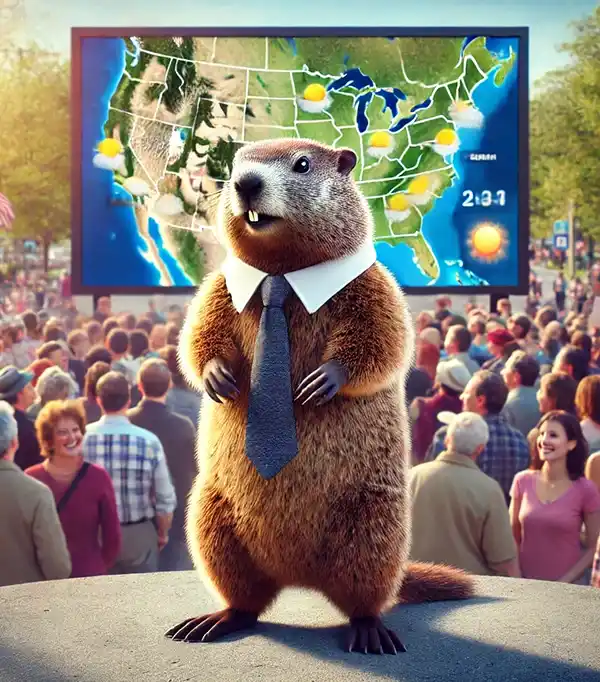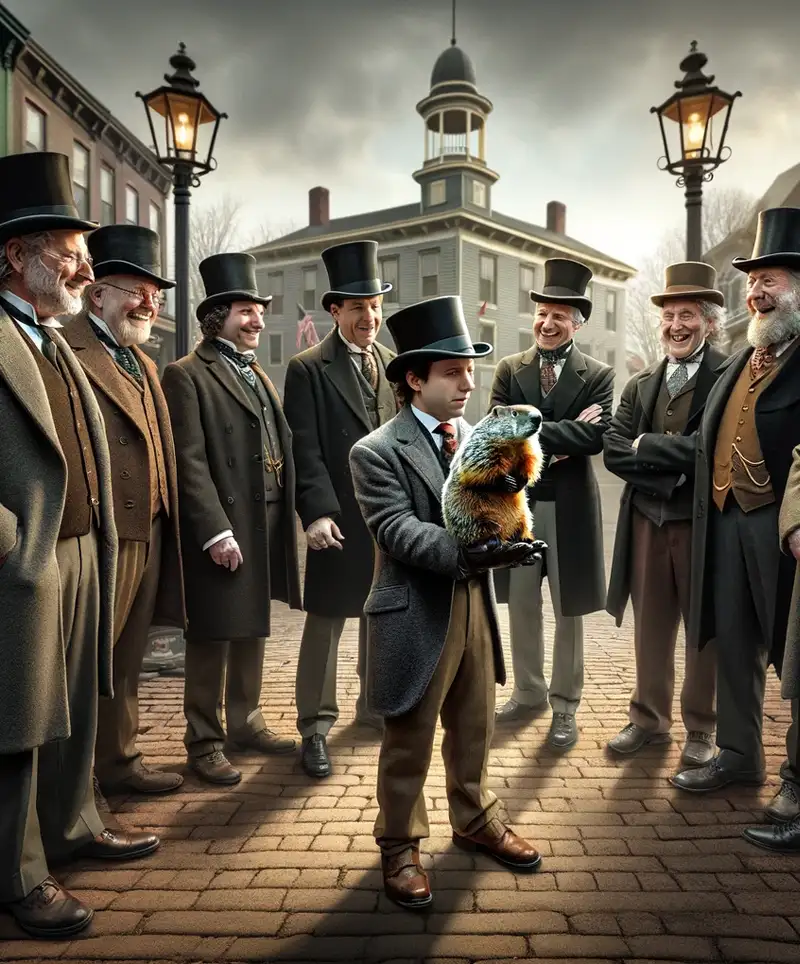A Whiskered Weatherman’s Winter Forecast
Groundhog Day is one of those quirky traditions that reminds us how strange (and wonderful) human culture can be. Every February 2nd, crowds gather in Punxsutawney, Pennsylvania—and in other towns across North America—to watch a groundhog make its annual weather prediction. But how did this peculiar event come about, and what’s the deal with putting so much trust in a large rodent? Let’s dig in.
 The Origins of Groundhog Day
The Origins of Groundhog Day
Groundhog Day’s roots trace back to ancient European traditions, particularly the Christian celebration of Candlemas. On this day, clergy would bless candles and distribute them to mark the halfway point of winter. Over time, folklore suggested that if Candlemas was sunny, the second half of winter would be long and harsh. This belief stemmed from the idea that clear weather on Candlemas allowed animals and other signs of nature to emerge from their winter respite, which was seen as a predictor of continued cold weather ahead.
Germans took this idea a step further by introducing an animal into the mix: the hedgehog. If the hedgehog saw its shadow on Candlemas, it meant six more weeks of winter. They believed the hedgehog’s behavior was tied to the changing of the seasons and its sensitivity to natural cycles.
When German immigrants settled in Pennsylvania in the 18th and 19th centuries, they brought this tradition with them. However, since North America lacked an abundance of hedgehogs, they substituted the groundhog. Groundhogs, or woodchucks, were abundant, familiar, and shared similar hibernation habits. And thus, the Groundhog Day we know today was born. Because, let’s face it, nothing says “accurate meteorology” quite like a groundhog.
The Star of the Show
Punxsutawney Phil, the most famous of all groundhogs, made his debut in 1887. According to local lore, Phil is the same groundhog today—kept alive by a magical elixir and a lot of wishful thinking. (Side note: either Phil is the world’s oldest living creature, or someone’s pulling a fast one on us.)
Every February 2nd, members of the Inner Circle—a top-hat-wearing, tuxedo-clad group of Phil’s handlers—gather at Gobbler’s Knob. In a ceremony that’s part weather report, part theatrical spectacle, Phil is coaxed out of his burrow. If he sees his shadow, winter continues for six more weeks. If not, spring is around the corner. Statistically speaking, Phil’s accuracy rate hovers around 40%. In other words, you might as well flip a coin.
Why a Groundhog?
Groundhogs, also known as woodchucks, are members of the marmot family. They’re expert diggers, spend a good chunk of the year hibernating, and—apparently—dabble in meteorology. These animals are a logical choice for the role, given their hibernation habits. As winter starts to wind down, groundhogs emerge from their burrows, giving the illusion they’re checking the weather.
But let’s be honest: the real reason for choosing a groundhog is that it’s just fun. No one’s clamoring for "Possum Prognostication Day" or "Badger Weather Watch."
Groundhog Day’s Cultural Impact
Thanks to the 1993 movie "Groundhog Day" starring Bill Murray, this humble tradition has taken on a new cultural significance. The film’s premise—a man reliving the same day over and over—has turned Groundhog Day into a metaphor for repetitive situations and second chances. It’s a story about growth, change, and the occasional frustration of hearing "I Got You Babe" on repeat.
Beyond its metaphorical value, the movie has become a beloved classic, introducing new generations to the holiday’s quirky charm. Fans often host "Groundhog Day" movie marathons on February 2nd, using the day as an opportunity to reflect on personal growth and self-improvement—or to laugh at Bill Murray’s existential crisis. The movie has also boosted the profile of Punxsutawney itself, turning the town into a tourist destination for both fans of the film and curious onlookers of the actual event.
 The broader cultural impact extends beyond cinema. References to "Groundhog Day" are common in everyday language, describing situations that feel monotonous or repetitive. In many ways, the day has become a lighthearted celebration of resilience and the human capacity for change.
The broader cultural impact extends beyond cinema. References to "Groundhog Day" are common in everyday language, describing situations that feel monotonous or repetitive. In many ways, the day has become a lighthearted celebration of resilience and the human capacity for change.
Beyond Punxsutawney
While Punxsutawney Phil is the A-list celebrity of weather rodents, other towns have their own furry forecasters. There’s Staten Island Chuck in New York, Wiarton Willie in Ontario, and Buckeye Chuck in Ohio, to name a few. Each groundhog has its own unique spin on the day’s festivities. And yes, there have been rivalries and controversies. In 2009, Staten Island Chuck bit New York City Mayor Michael Bloomberg, proving that weather prediction is a dangerous business.
Wiarton Willie, for example, adds a distinctly Canadian twist to the holiday, complete with parades, pancake breakfasts, and winter sports. In Sun Prairie, Wisconsin, their groundhog—Jimmy the Groundhog—delivers his forecast in a slightly less theatrical but equally beloved ceremony. These local traditions often feature colorful commentary, live music, and plenty of community spirit.
Each town’s event reflects its own local flavor, highlighting the creativity and enthusiasm that make Groundhog Day a cherished celebration. Some even argue that these smaller ceremonies, with their grassroots charm, embody the true spirit of the holiday more than Punxsutawney’s media spectacle. Whether it’s Wiarton Willie or Staten Island Chuck, the day unites communities in a shared appreciation for the odd and delightful.
The Science (or Lack Thereof)
Let’s address the elephant in the room: Groundhog Day has zero scientific basis. Meteorologists use advanced technology, including satellites and computer models, to predict the weather. Groundhogs, on the other hand, rely on instinct and possibly a touch of stage fright. Unlike professional weather forecasters, groundhogs do not consider atmospheric pressure, wind patterns, or ocean currents—mostly because they are busy eating clover and digging burrows.
Still, Groundhog Day is less about science and more about tradition and entertainment. People love an excuse to gather, celebrate, and enjoy a break from the monotony of winter. The event also reminds us that humans have always sought ways to predict and make sense of the natural world, even if those methods seem humorous or outdated by today’s standards. So, while a groundhog’s weather prediction may not be reliable, the joy it brings is certainly real.
Fun Facts About Groundhog Day
Groundhog Day has its fair share of trivia and curious tidbits that add to its charm. Before we dive into the list, it’s worth noting that this holiday’s enduring popularity owes much to its sheer eccentricity. After all, how many holidays are built around the whims of a rodent? Now, let’s explore some fun facts:
- Phil’s Full Title: Punxsutawney Phil is officially known as “The Seer of Seers, Sage of Sages, Prognosticator of Prognosticators, and Weather Prophet Extraordinary.” Try fitting that on a name tag.
- Movie Filming: Despite being set in Punxsutawney, the movie "Groundhog Day" was actually filmed in Woodstock, Illinois.
- Global Appeal: While it’s a North American tradition, Groundhog Day has inspired similar events worldwide because who wouldn’t want to see a marmot predict the weather?
- The Weight of Phil’s Role: Phil typically weighs around 20 pounds, making him one hefty forecaster.
- Other Animals as Weather Forecasters: In Alaska, they celebrate Marmot Day instead of Groundhog Day, as marmots are more common there.
- Phil’s Fame: Punxsutawney Phil has his own fan club and is even featured in local tourism campaigns to boost the town’s economy.
- Live Streaming the Event: In recent years, Gobbler’s Knob has embraced technology, allowing people worldwide to watch Phil’s prediction online.
- The Elixir of Life: Legend says Phil is fed a special “elixir” every summer that extends his life by seven years. If only the rest of us had access to this secret potion!
Groundhog Day is more than just a quirky ritual; it’s a celebration of whimsy, community, and the simple joys of life. Whether or not Punxsutawney Phil’s predictions hold any weight, the tradition brings people together and gives us something to look forward to during the dreary days of winter. Plus, who can resist the charm of a weather-predicting rodent?
Please Share our Content






 The Origins of Groundhog Day
The Origins of Groundhog Day The broader cultural impact extends beyond cinema. References to "Groundhog Day" are common in everyday language, describing situations that feel monotonous or repetitive. In many ways, the day has become a lighthearted celebration of resilience and the human capacity for change.
The broader cultural impact extends beyond cinema. References to "Groundhog Day" are common in everyday language, describing situations that feel monotonous or repetitive. In many ways, the day has become a lighthearted celebration of resilience and the human capacity for change.








 "Sláinte!" is a traditional Irish expression used as a toast, equivalent to "Cheers!" in English.
"Sláinte!" is a traditional Irish expression used as a toast, equivalent to "Cheers!" in English.